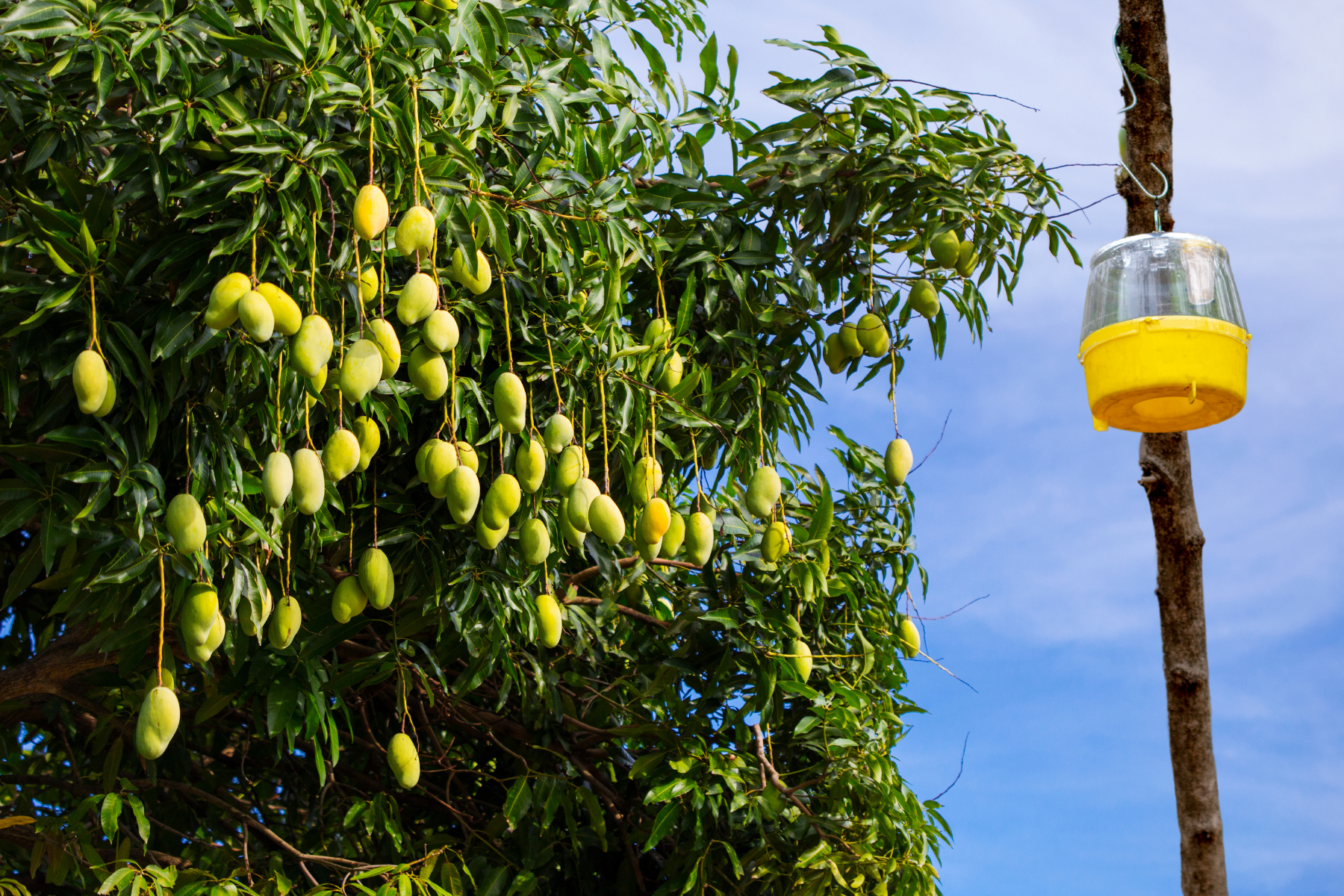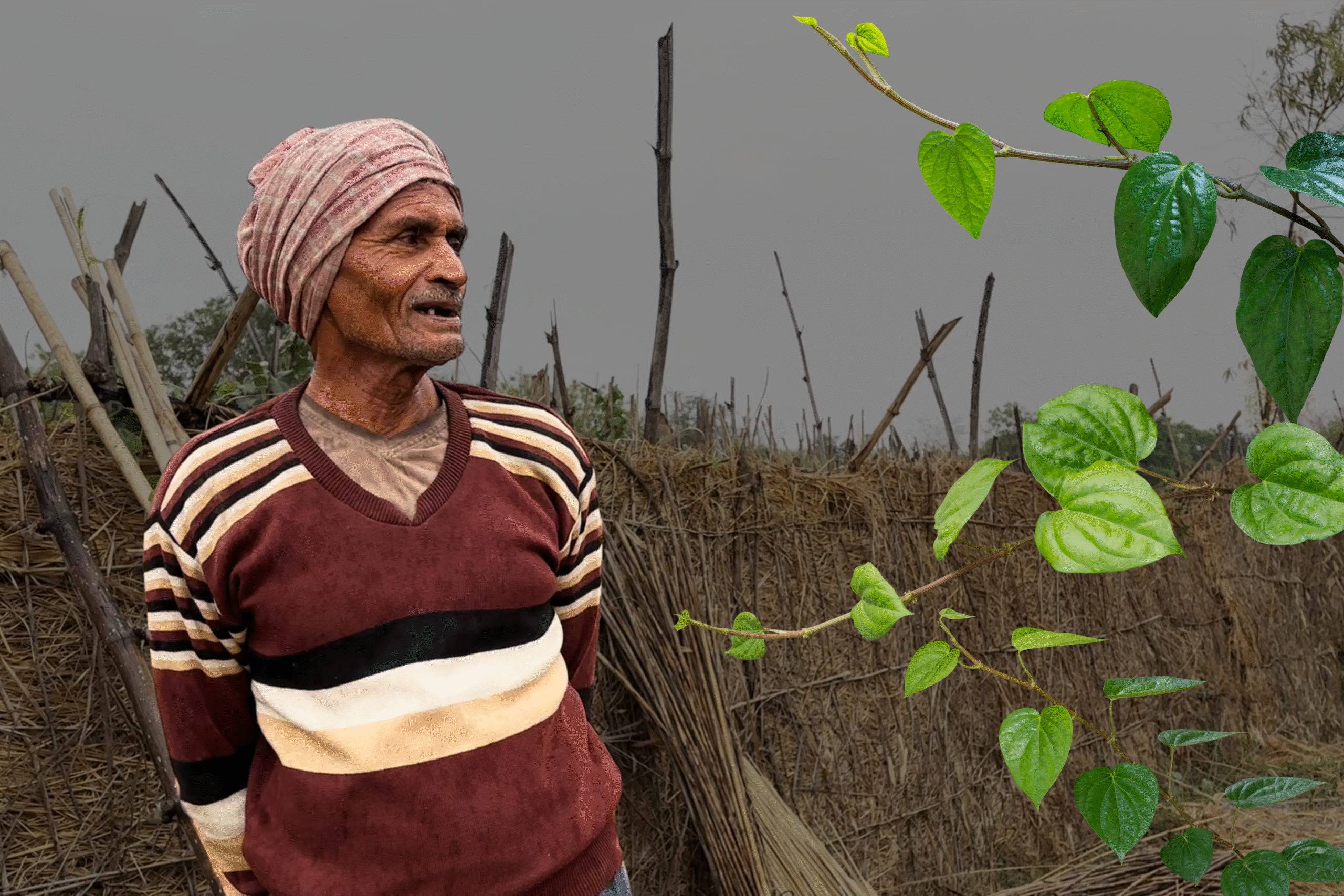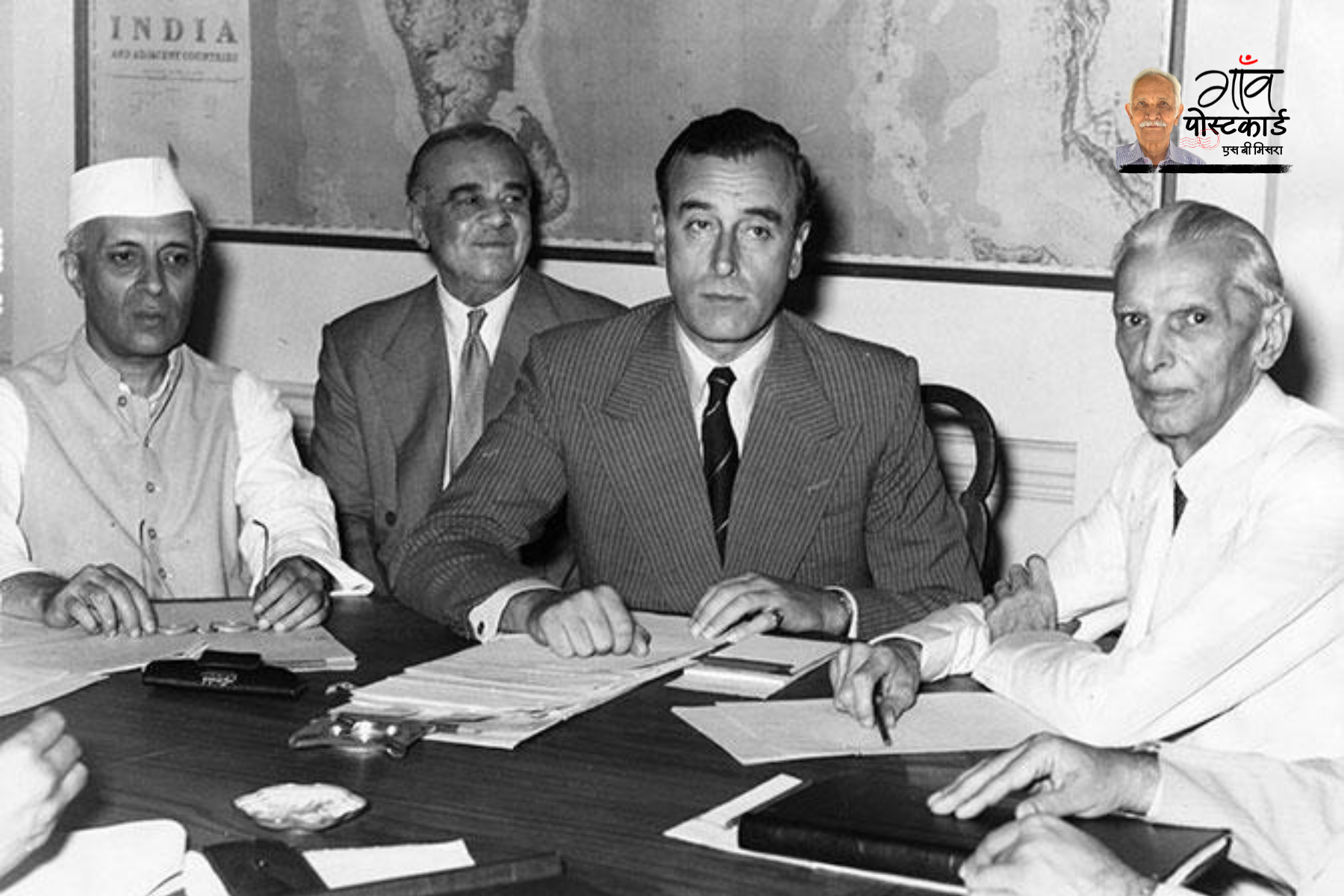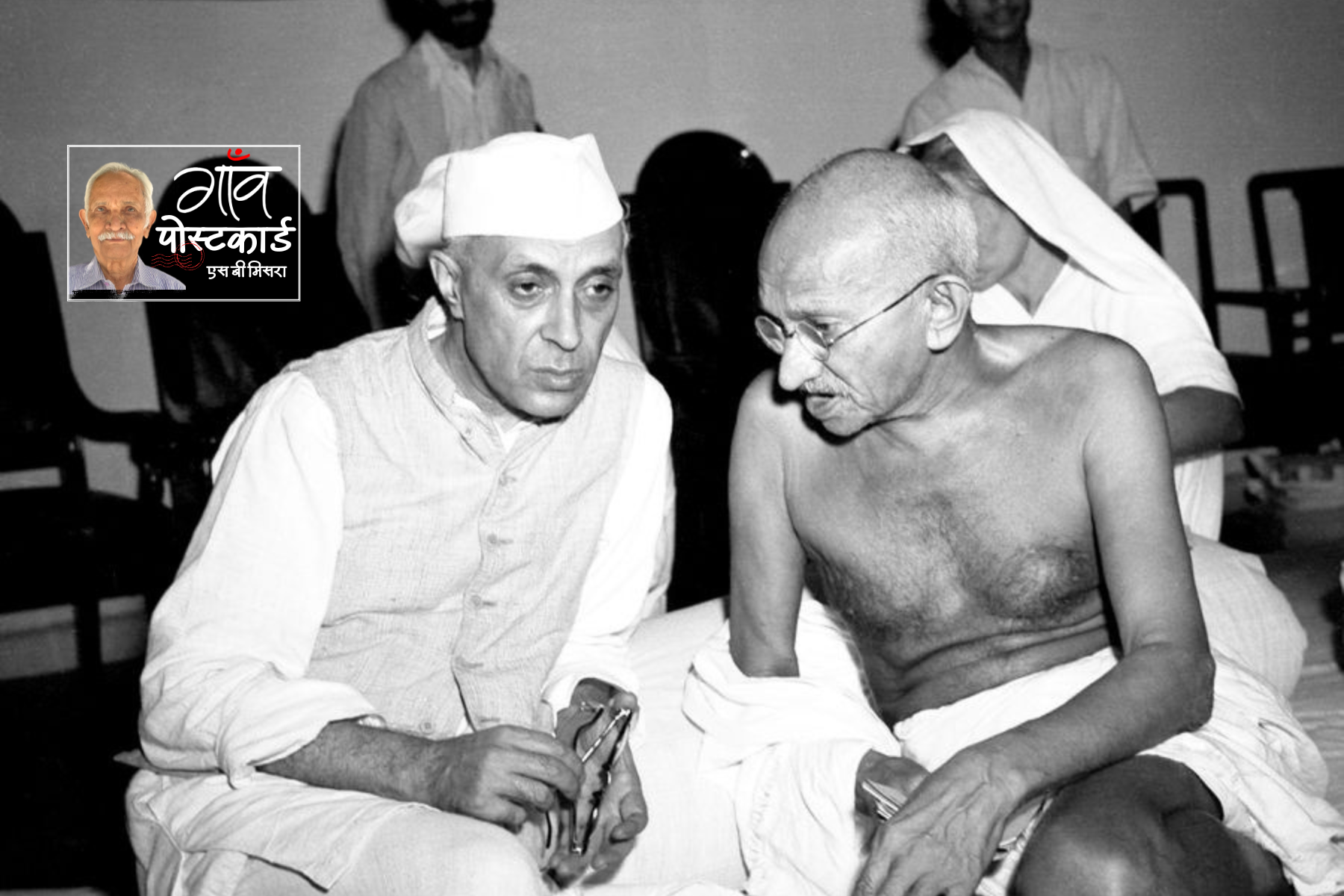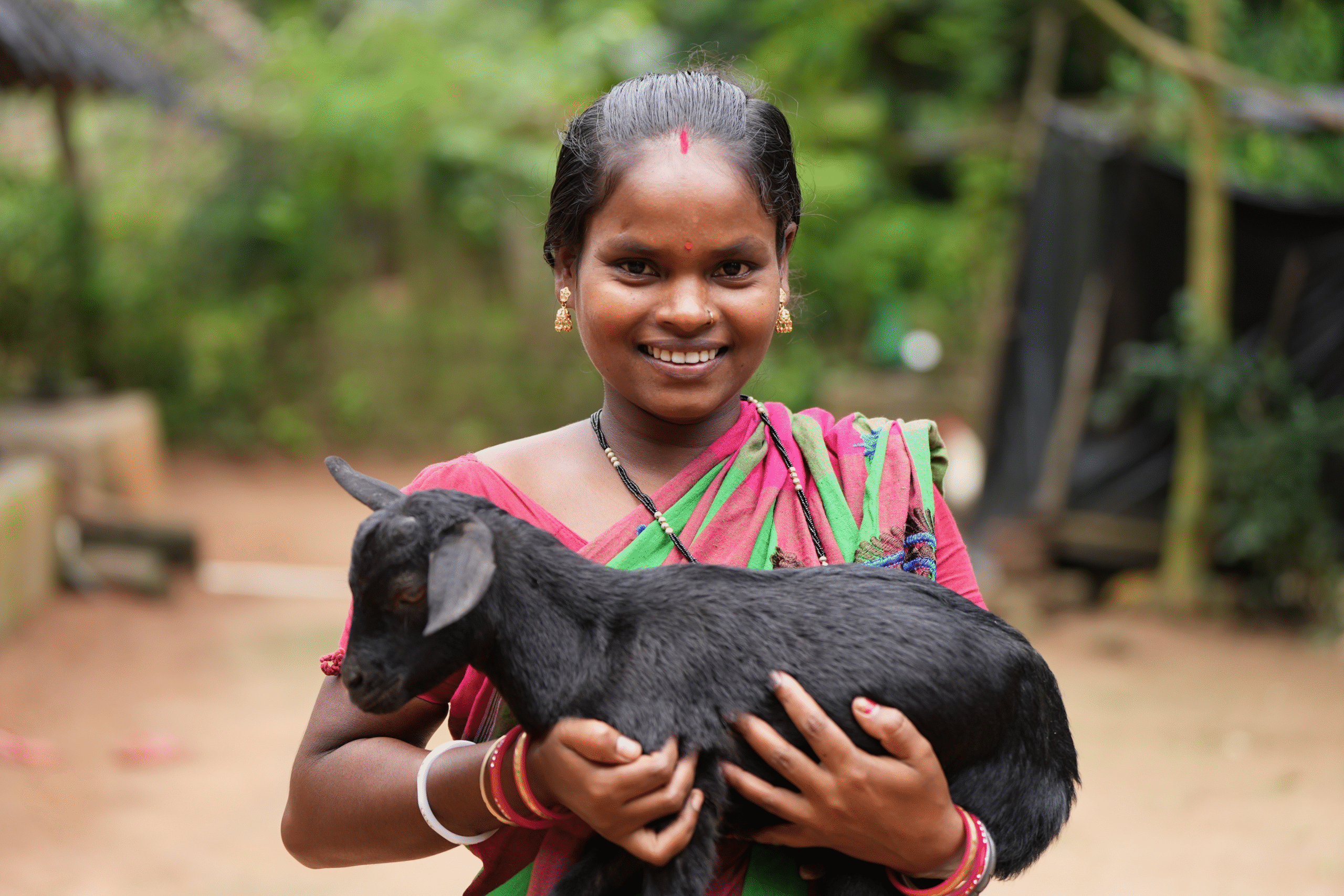Pohri (Shivpuri), Madhya Pradesh
As a bout of coughing racked her frail body, Angoori clutched a talisman that she wore around her neck. “Ever since I got this tabeez (talisman), the medicines have started working,” the 23-year-old from Upsil village in Shivpuri district, Madhya Pradesh, told Gaon Connection.
Angoori and her husband Lallan Singh live in one room with their three daughters aged seven, six and three years, respectively. The couple belongs to the Saharia tribe, which is a particularly vulnerable tribal group (PVTG).
Angoori has been under medication for tuberculosis (TB) since January this year, but because she could not continue with the medicines, she had a relapse.
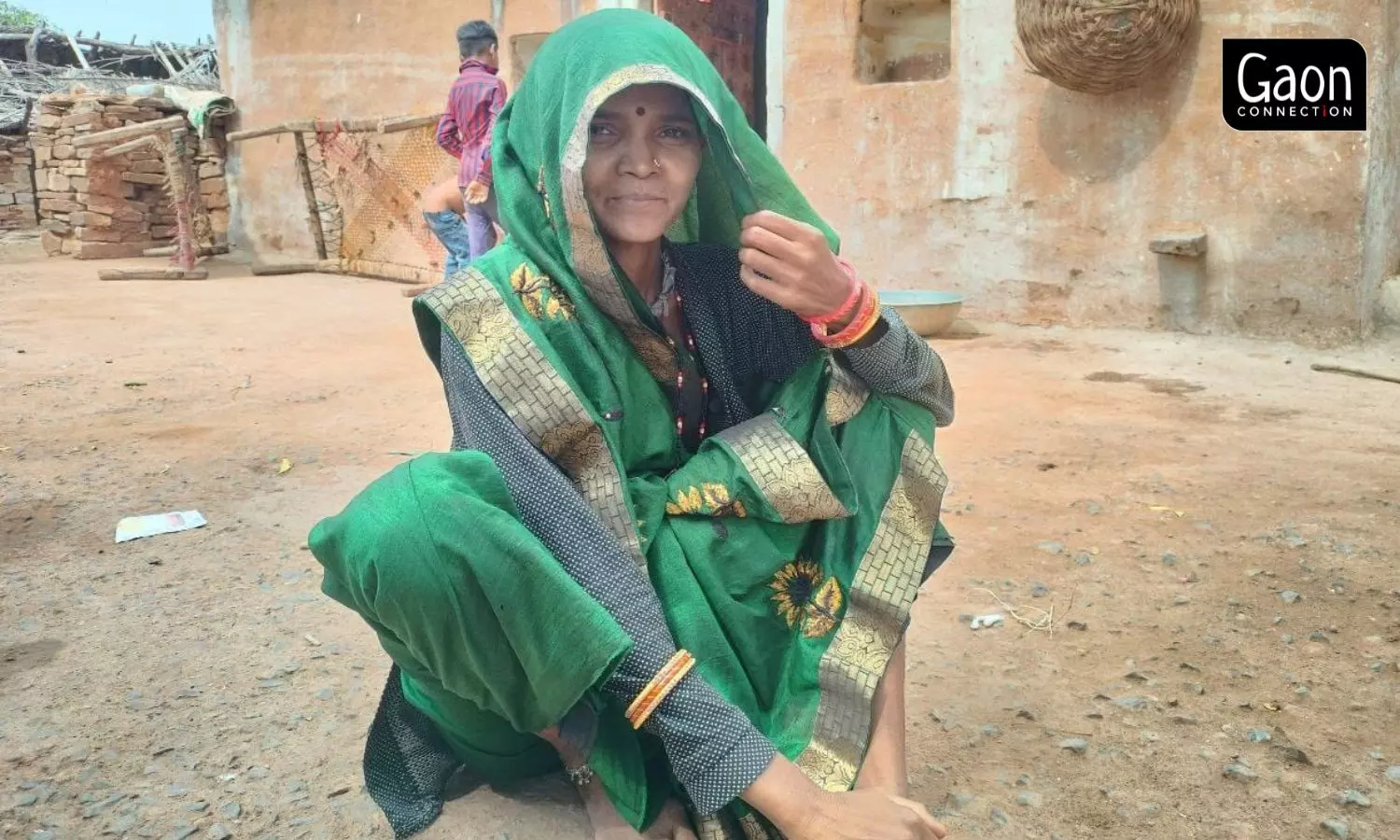
Angoori is undernourished and weak weighing only 38 kgs. She lives with her husband Lallan Singh and their three daughters in one room.
Weighing only 38 kgs, Angoori is visibly undernourished and weak. “We had four daughters. But my youngest, Urmila, died two months ago. She was only two years old,” said Angoori.
Urmila was undernourished and according to Lallan Singh, she had a cough. “We took her to the ojha (village healer). She found some relief, but within four days she was dead,” 28-year-old Lalan Singh, a daily wage labourer, told Gaon Connection.
Despite this tragedy, Angoori and Lallan Singh still believe the ojha has healing powers that far exceed conventional medicines from a certified health centre.
Malnourishment, tuberculosis and superstition are rampant in the Saharia tribe of Madhya Pradesh. “The Saharia community has a long history of tuberculosis. Ever since the essentially forest-dwelling tribal inhabitants came out of the forests and settled outside, they have battled TB as well as malnourishment,” Ajay Yadav of Vikas Samvad, a non profit that works to end tuberculosis and malnutrition, told Gaon Connection.
Three kilometres away from Upsil is Bhainsda village. Till two months ago, this village was home to Neelam who was just one year old. She died of malnutrition and TB, said her grieving parents Anari and Prakash.
“We have seven TB patients in the village who are undergoing treatment. But we have already lost three others this year due to TB,” Puniya Adivasi, ASHA worker at Bhainsda village, told Gaon Connection.
According to Puniya, she keeps an eye out for anyone who has been coughing for more than 15 days. “We take their weight and send their phlegm for testing. We do that once a week,” she said.
In case, someone tests positive, their treatment is started immediately and it carries on for six months. “But not everyone in the village completes the six-month course of medication,” she said. A majority of the village inhabitants belong to the Saharia tribal community.
Large families living in close proximity in small spaces compounds the problem. Sheela Sahariya in Bhainsda village lives with six other family members in one room, measuring no more than 10 ft by10 ft.
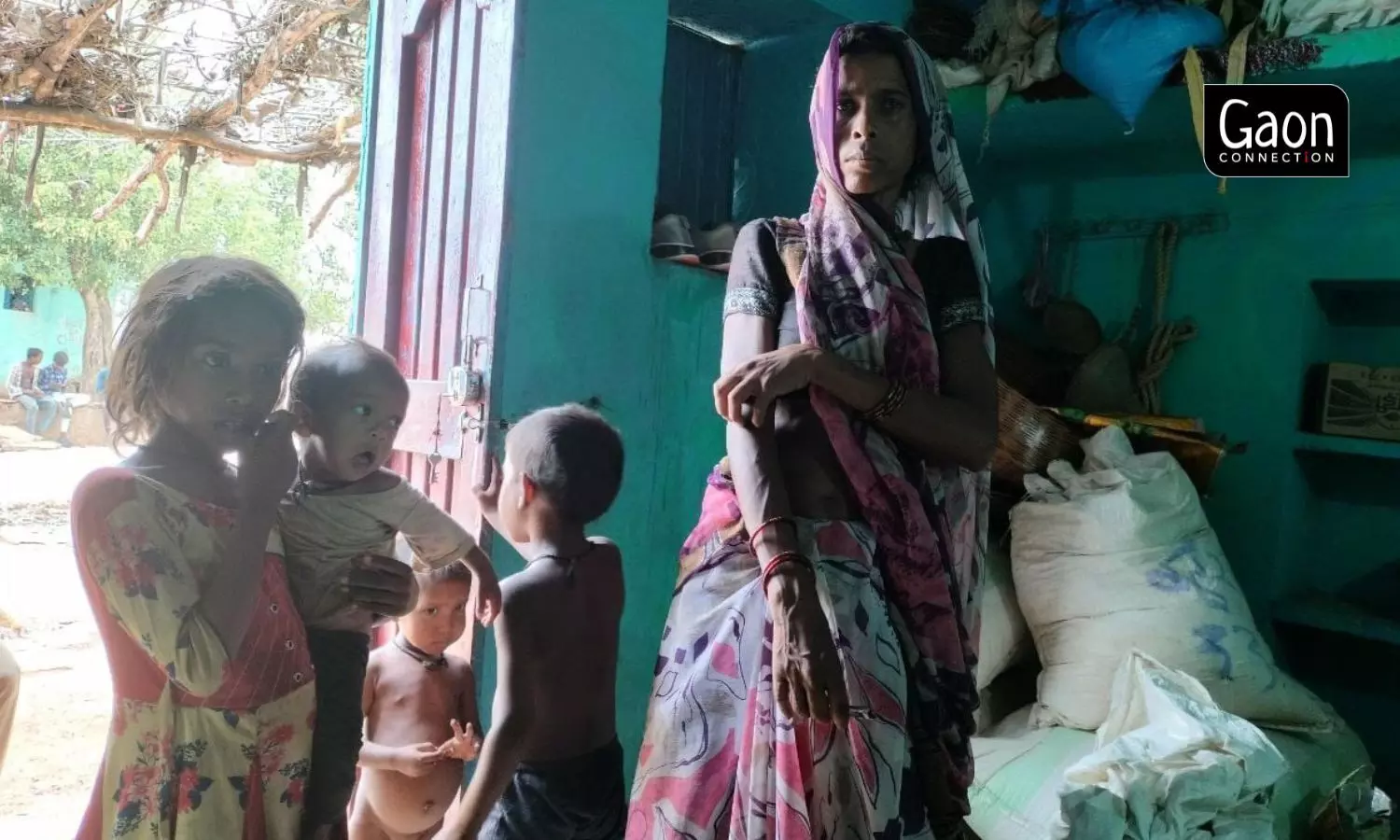
28 year old Sheela lives in Bhainsda village with six other family members. She had TB and while it improved for a while, the cough has started again.
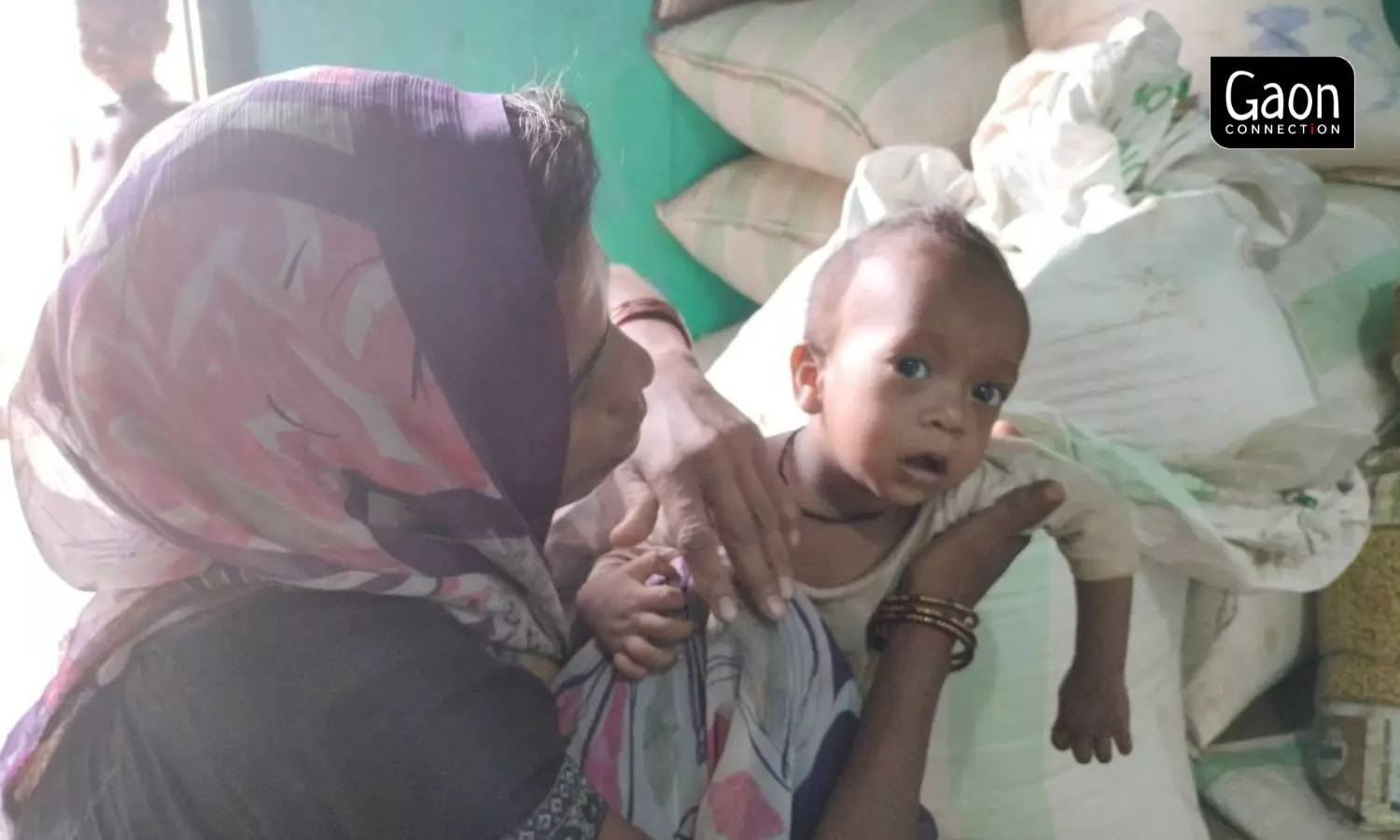
Sheela’s 10 months old son is severely malnourished.
“I had TB. And while I improved for a while, the cough has started again. I feel tired even if I take a couple of steps,” 28-year-old Sheela, who held her 10-month old baby boy close in her arms, told Gaon Connection. She has three daughters and one more son aged between three and seven years. Her husband Baisram is an agricultural labourer who has not had a job since the harvest in April.
About 43 kilometres from Sheela’s Bhainsda village is the Nutrition Rehabilitation Centre in Shivpuri district hospital. At this Centre, there is space to accommodate 40 children at a time. “But we always have double the number of children admitted,” Manju Gupta Auxiliary Nurse and Midwife (ANM) at the hospital, told Gaon Connection. “So far this year, we have already had 40 children coming here with TB,” she said.
According to the WHO Global TB report 2022, India’s tuberculosis incidence for the year 2021 is 210 per 100,000 population. Of the estimated 9.96 million incident cases of TB globally in 2019, 2.64 million occurred in India alone, thus accounting for more than a quarter of the world’s TB cases.
The high TB burden in the tribal population is a major challenge for the National TB Elimination Programme of the Indian government. Limited access to health facilities combined with poverty, under-nutrition, tobacco and alcohol abuse makes management of TB difficult in tribal populations.
According to a June 2022 paper published in PLOS Global Public Health, Saharia PVTG in the central Indian state of Madhya Pradesh has the highest reported tuberculosis prevalence in the country ranging from 1,270 to 3,294 per 100,000 population. This is more than ten times compared to the national estimated prevalence.
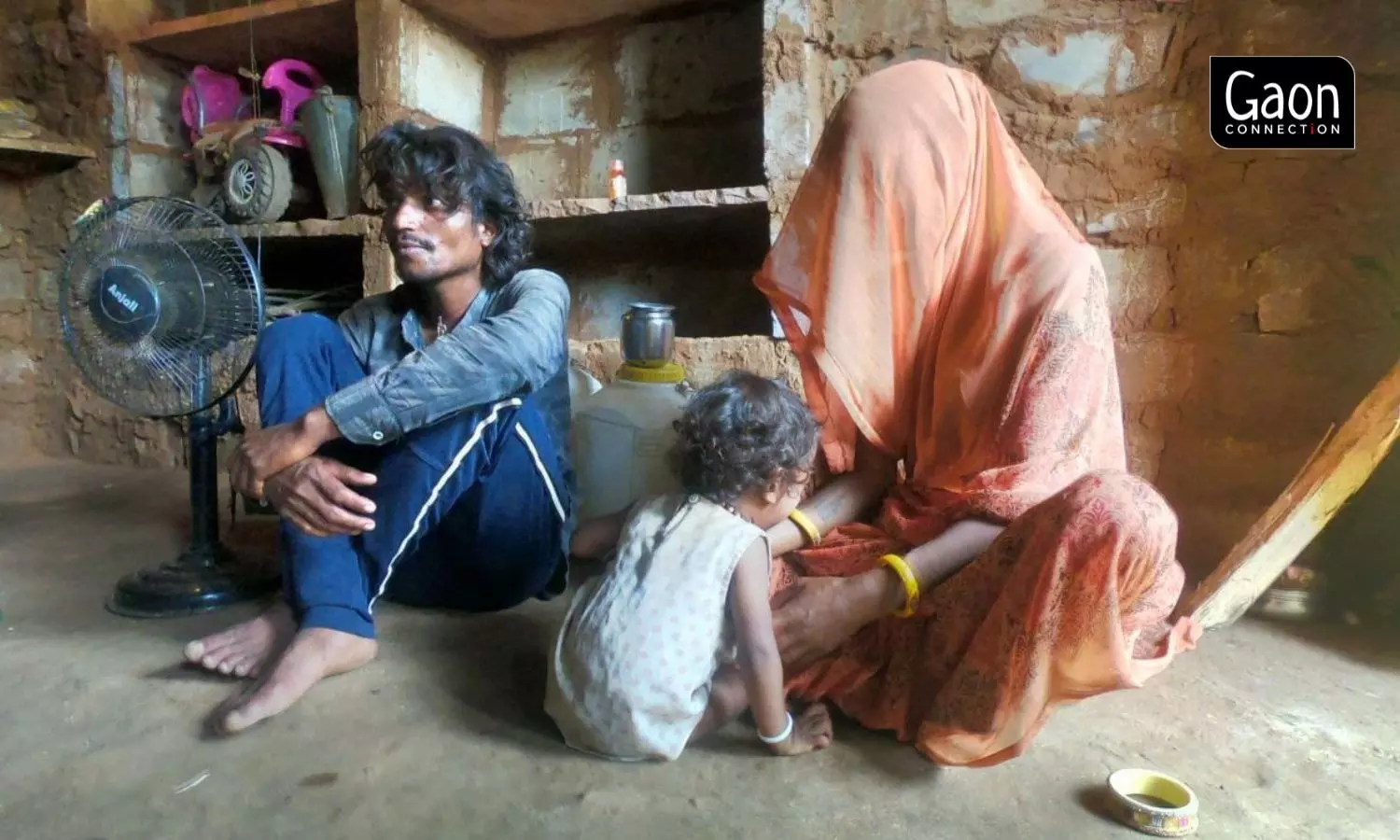
With limited access to health facilities combined with poverty, under-nutrition, tobacco and alcohol abuse it makes management of TB extremely difficult in tribal populations.
The findings of the June 2022 study, the first of its kind in the Saharia tribal population, indicate a high incidence of pulmonary TB in this tribal community thereby highlighting the urgent need for focused and intensified efforts to achieve the goal of TB elimination in the country.
Ajay Yadav, the Pohri-based social worker, said how the government was trying its best to end tuberculosis and malnutrition amongst the Saharia community.
“But despite many welfare schemes, poverty, unemployment, alcoholism, superstition amongst the people, are coming in the way of effective solutions,” he said. Only if these were eradicated first would they win the battle against TB and malnutrition, Yadav added.
Describing TB and malnutrition as intertwined and a vicious circle, Yadav said that the Saharia people depended on physical labour for their livelihood.
“I have seen three generations of the same family suffer and die of tuberculosis. It is sad that while their kind of work requires stamina and physical strength, they fall prey to tuberculosis that wastes their body away,” said Yadav. This has a direct impact on their lives and the lives of their family, even the coming generations.
Community-based awareness programmes
But there have been success stories, pointed out Yadav.
“Since 2018, Vikas Samvad has run a community-based awareness programme on malnutrition in 15 Saharia-dominated villages. In each village there are four groups that work with frontline health workers and the health department,” he explained.
These groups spread awareness, maintain records and keep an eye out for signs of TB or malnutrition in the inhabitants of their village. “They pay special attention to pregnant women and children. They ensure their weight is taken at regular intervals and they have a proper diet and are inoculated as per requirement,” said Yadav.
The groups monitored children with Severe Acute Malnutrition (SAM), and worked closely with anganwadis to ensure the children followed a nutritious diet.
The impact of all the good work is evident. “Before 2018 nearly 33 children died of malnutrition or other diseases in 15 villages of Pohri block. Today it is no more than three. We have also taken on the responsibility of treating TB patients in four villages,” said Yadav.
He went on to inform that since August 2022, their team was working in four villages where there were 24 TB patients. “We have helped treat 14 patients and now only 10 are left,” informed the social worker.
Also Read: Fighting tuberculosis with nutri-gardens
It has been an uphill challenge, the social worker admitted. There is a stigma attached to tuberculosis. People associate it with sure death and also, anyone with TB is completely shunned as a result of which people do not want to tell anyone if they have the symptoms of tuberculosis, said Yadav.
When it comes to malnutrition, most people believe it is because of jaadu tona or black magic, because of which the child wasted away and finally died, he said. New mothers do not feed their child the first milk. There is some superstition about it, whereas the first lactation is extremely nutritious for the baby.
Will Shivpuri be TB-free by 2025?
On contacting Dr Alka Trivedi, TB officer of Shivpuri district, she responded, in writing, about the steps being taken by the authorities to combat TB and malnutrition.
“We are working closely with the health department, panchayats, rural development department, and field workers and non profits to eliminate TB by 2025,” she wrote.
Elimination of Tuberculosis is one of the sustainable development targets to be achieved by 2030 by the world, and India has set the target of 2025.
According to Dr Trivedi, the district currently has 2,994 TB patients of which 643 are from the Saharia community. There are 126 children who are being treated for TB in the district, she added.
The district TB officer went on to inform that according to the Annual TB Report 2023, in Madhya Pradesh, there are a total of 85,628 notified TB patients so far. Of these, 28,299 people are from tribal communities. Since June 2022, there are 4,542 notified TB patients in the district of Shivpuri of which 2,994 are still being treated.


